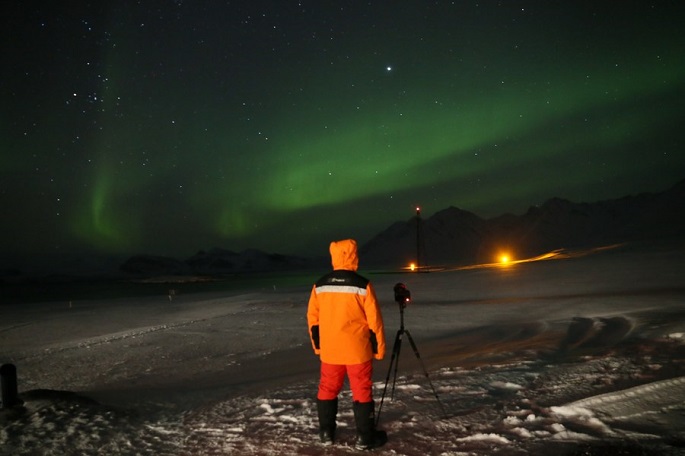Lone Chinese researcher's winter in the Arctic
Published : 28 Nov 2023, 22:55
The small town of Ny-Alesund lies in the heart of the Svalbard archipelago between mainland Norway and the North Pole. It hosts the world's northernmost year-round research station, which is pivotal to the exploration of Earth's polar extremes. The compound included the Yellow River Station, China's first Arctic research station.
In wintertime in this land of eternal darkness, Li Bin, a deputy researcher at the Polar Research Institute of China, holds the fort, his only companion being the mesmerizing dance of auroras across the night sky.
VIGILS IN ARCTIC NIGHT
Situated at 79 degrees north in the northwestern region of Spitsbergen, the largest island in Norway's Arctic Svalbard archipelago, Ny-Alesund is the world's northernmost permanent settlement.
Once a thriving coal mining town, Ny-Alesund now buzzes with the activities of polar researchers. Since the Yellow River Station's inception in 2004, China has established a significant presence in this scientific sanctuary.
Polar life in the Yellow River Station is divided into two distinct seasons. The summer months are a hive of activity, seeing an influx of researchers from Chinese institutions, engaging in varied studies from glaciology to atmospheric sciences.
Winter, however, ushers in a period of challenges as the relentless polar night descends. The rhythm of day and night blurs, with polar night enveloping the region for over 120 days from late October to late February.
Li, specializing in space physics and aurora observation, becomes the lone guardian of the station during these long, dark months this year.
Li's days are marked by a unique cadence. Mornings start with coordination with his colleagues back in China, followed by familial video chats post their workday.
In the afternoon, Li's vigil begins. He meticulously monitors aurora observation instruments located across Ny-Alesund, Longyearbyen in Svalbard and Laugar in Iceland, gathering data that feeds into the global pool of aurora research.
On nights graced with vibrant aurora displays, Li ventures into the frigid wilderness, his camera and tripod in tow, to capture the ethereal beauty of the Northern Lights.
In the face of heavy snowfall, he endures the harsh cold, trudging through the snow to maintain the essential equipment, ensuring their uninterrupted function.
In this remote outpost, the canteen serves as a communal hub, providing sustenance for the international research community.
After working overnight, Li often misses breakfast and takes his first meal of the day at noon. Late night hunger is often satiated with simple fare like instant noodles or canned salmon.
EXPLORING ENIGMA OF AURORAS
In the remote and icy landscapes of Ny-Alesund, scientists like Li Bin delve into the mysteries of auroras, those captivating natural light shows predominantly seen in the planet's polar regions.
The auroras, primarily occurring in high-latitude areas with magnetic fields, are caused by charged particles from the magnetosphere and solar winds entering the Earth's atmosphere and colliding with atmospheric atoms, resulting in ethereal green and red lights.
Beyond their breathtaking beauty, these auroras hold key insights for space physics, Li explained.
"Auroras offer a window into the Earth's magnetosphere, providing essential data that enhance our comprehension of Earth's space environment. This knowledge is crucial for fields like satellite deployment and aerospace communication."
He likened auroras to the "rain and snow" of Earth's high-latitude spatial environment, significantly influencing infrastructure in these regions.
By studying auroras, scientists can anticipate and mitigate the effects of space storms on critical technology like communication satellites and power grids, he said.
Li drew an analogy to everyday life to underscore the significance of his work: "Just as people check weather forecasts before stepping out, auroras are akin to a 'space weather forecast'."
"As human excursions into space become more frequent, our reliance on these forecasts will intensify. Understanding the 'storms' of space is pivotal for future space trips, and studying auroras is a critical step in this journey," he said.
LONE GUARDIAN
The life of a polar researcher is not without perils and challenges. In the desolate expanses of Ny-Alesund, dangers lurk in the form of polar bears, and the psychological toll of enduring months of unending polar night is substantial.
Structures in Ny-Alesund, including the Yellow River Station where Li Bin works, are left unlocked to offer sanctuary from potential bear encounters, with doors designed to open outward -- a simple yet effective measure against polar bears, which are known to push but not pull doors.
He Fang, a deputy researcher at the Polar Research Institute of China with experience in overwintering in both Antarctic and Arctic stations, spoke about the mental fortitude required in these extreme conditions.
"Wintering in the polar region often means solitary months in unyielding darkness. One must constantly adapt, mentally and physically, to this relentless environment of endless night," he said.
However, Li's commitment remains unwavering. "I'm drawn to the polar regions and their auroras."


